During the late stages of pregnancy and childbirth, many women experience a separation of their abdominal muscles called diastasis recti, which can cause abdominal pain, weakness, and visual abnormalities.
While “diastasis” often resolves on its own, many women want to accelerate the process by performing diastasis recti exercises, which are exercises that help you minimize the gaps in your abs and help you regain your pre-baby strength.
In this article, you’ll learn everything you need to know about how to fix diastasis recti, including what diastasis recti is, how to check for it, several excellent exercises for diastasis recti, a 6-week training program to accelerate your postpartum recovery, and more.
Table of Contents
+
What Is Diastasis Recti?
Diastasis recti is the natural separation of the abdominal muscles during the late stages of pregnancy and childbirth. In most cases, it resolves spontaneously in the weeks and months following delivery, though recovery times vary from woman to woman.
For instance, research shows that around 60% and 33% of women still have some ab separation 6 weeks and 12 months postpartum (after childbirth), respectively.
It happens when the linea alba, the connective tissue that joins the two vertical columns of the rectus abdominis muscles (abs), stretches and thins to make room for your growing baby.
For many women, diastasis recti is solely an aesthetic concern, though some report impaired abdominal strength, abdominal, low back, and pelvic girdle pain, and pelvic floor disorders.
Doctors diagnose diastasis recti based on the width of the separation in your abs. If the separation exceeds 2 centimeters at one or more points of the linea alba, they’ll likely diagnose you as having diastasis recti.
Separations typically measure between 2 and 5 centimeters wide and can vary in length from 2 centimeters to the entire length of your abs. Research shows that separations most often occur around the height of your umbilicus (belly button), though in ~37% cases they appear above, and in ~11% of cases they appear below.
Here’s an illustration of the different ways diastasis recti can manifest:

How to Check for Diastasis Recti
The test for diastasis recti is simple, which is why many women prefer to do it themselves rather than visit a medical professional. Here’s how to do it:
- Lie on your back on the floor and place your feet 6-to-12 inches from your butt. Lift your shirt to uncover your belly.
- Raise your head off the floor so that you’re looking toward your belly and support its weight with your left hand. Don’t pull your head up, lift your shoulders off the floor, or try to “crunch” your torso toward your legs using your abs.
- With your right hand, gently examine the areas above, around, and below your belly button, feeling for any gaps in your abs and the texture of the tissue down the midline of your belly.
- Using your finger tips, measure the length and width of any gaps you find. For example, if you can fit two finger tips horizontally in a gap, the gap is likely around 2 centimeters wide.
- As well as searching for gaps in your abs, try to gauge the integrity of the tissue between your ab muscles. Under normal circumstances, the linea alba should feel strong. A linea alba that feels more like jelly is a sign you’re still not fully recovered.
You can typically resolve diastasis recti at home, provided any gaps you find are five centimeters (finger breadths) wide or less. If you find a gap that’s larger than this, it’s sensible to see a doctor or physical therapist who specializes in diastasis recti to discuss the best course of action.
How to Fix Diastasis Recti
If you establish that you have diastasis recti, and the gap in your abs is five centimeters wide or less, here’s what you can do to help fix it.
1. Allow yourself time to recover before starting intense exercise.
Many women are desperate to return to their normal exercise regimen immediately after giving birth, but this isn’t a good idea. Most health professionals recommend taking up to 6 weeks to recover after vaginal deliveries and up to 10 weeks following a Cesarean section before you start lifting weights, doing cardio workouts, and so forth.
While intense exercise is ill advised during this recovery period, there are things you can do to optimize the healing process, including correcting your posture, improving how you move your body during everyday tasks, and performing breathing, pelvic floor, and core-strengthening exercises.
2. Correct your posture and learn to get up and lie down properly.
During the early postpartum period (~1-to-2 weeks post childbirth), experts agree that it’s important to learn ways to perform everyday tasks that prevent you from increasing intra-abdominal pressure (pressure in your belly).
The most common ways to do this are adopting a relaxed, neutral posture and learning to get up and lie down without straining or “crunching” your abs.
Here’s how to do both.
How to Correct Your Posture
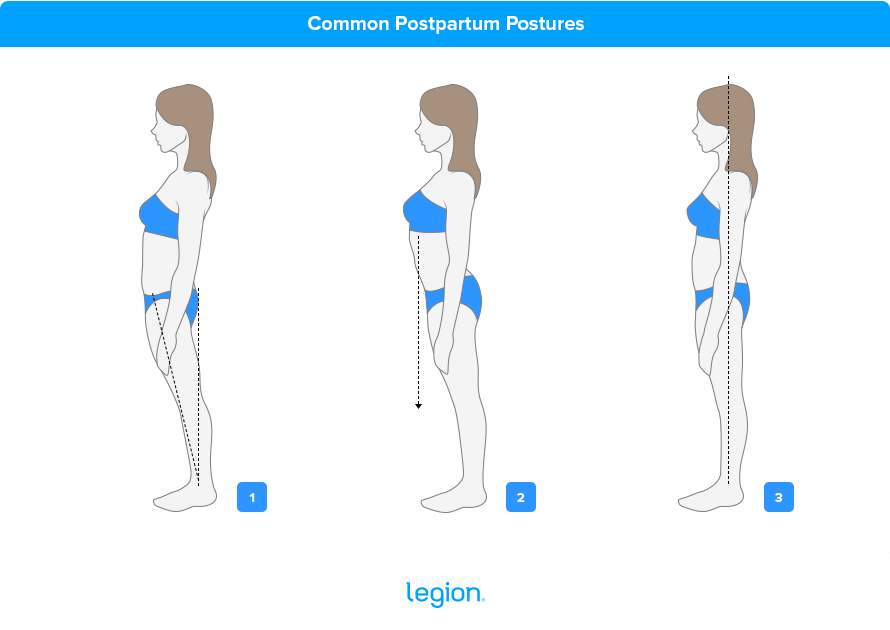
Many women find their posture changes after giving birth. Some women find they arch their back more than before, pushing their pelvis out in front of the chest and knees (figure 1 in the illustration above), while others find their lower-back muscles overcompensate for their weaker abs, pushing their chest out and rotating the front of their pelvis toward the floor (figure 2).
While there’s no such thing as “perfect posture,” maintaining a neutral posture with your shoulders, hips, knees “stacked” on top of each other is likely better for minimizing diastasis recti (figure 3).
Throughout each day, get into the habit of checking your posture as you perform day-to-day tasks. For example, while you brush your teeth, think about maintaining a neutral spine rather than hunching over the sink, or while carrying your newborn, make a conscious effort to ensure your hips are under your shoulders, not jutting out to the side.
How to Get Up and Lie Down
Moving from prone to sitting and vice versa increases intra-abdominal pressure, which can worsen the separation in your abs.
To minimize this, here’s how to get up:
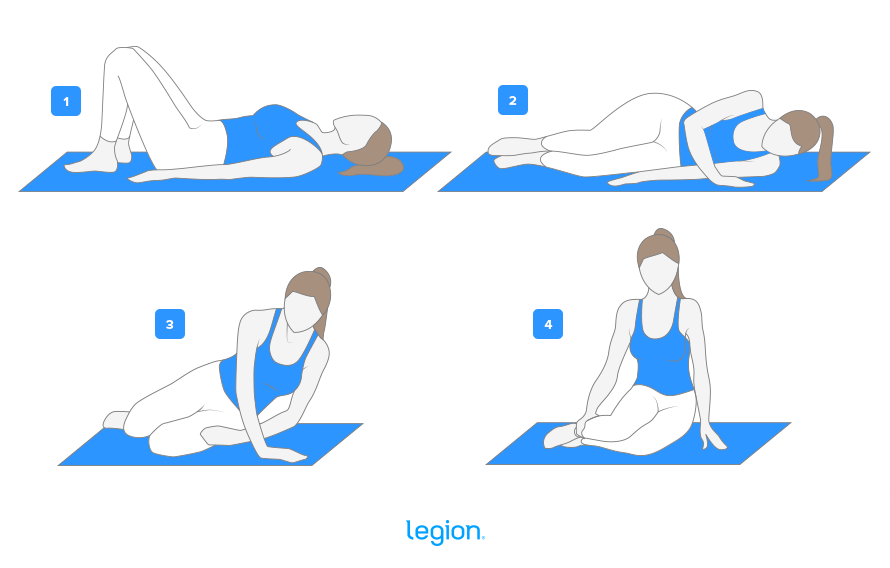
- While lying on your back, engage your abs by “pulling” them toward your spine.
- Roll to your left side, placing your left arm flat on the floor with your palm facing downward. Bring your right arm across your body, placing your right palm on the floor at chest height.
- Keep your abs engaged and press through your right arm until you’re sitting upright with your legs to your right.
- Once upright, take a second to steady yourself. You can use your hands on either side of your body if necessary.
To lie down, use the same steps in reverse:
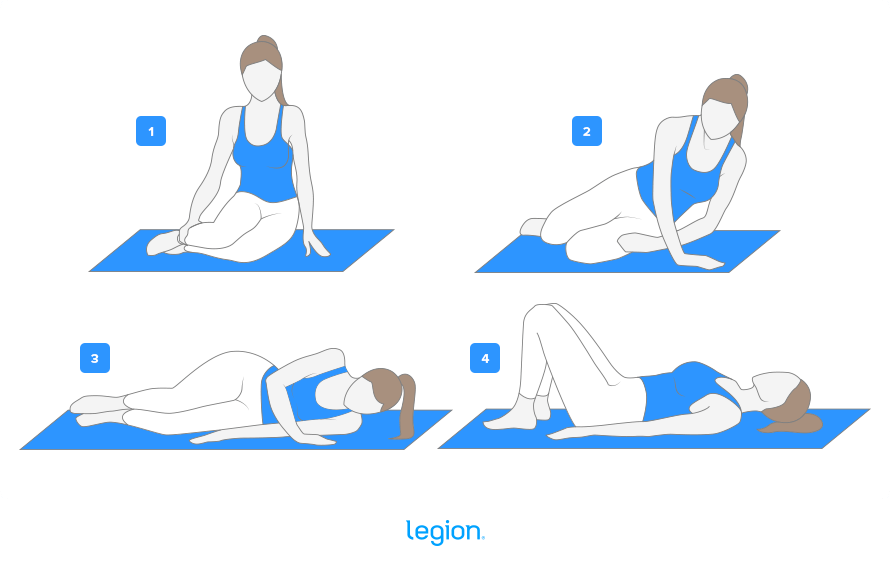
- Sit down with your legs to your left.
- Engage your abs by “pulling” them toward your spine, then place your right hand on the floor in front of your left shoulder.
- Take most of your weight on your right arm, then slowly bend your right elbow to lower yourself toward the floor. As you lower yourself, let your left arm slide between your right hand and your body until it’s flat on the floor.
- Once you’re lying on your left side, roll to your back.
3. Do breathing and pelvic floor exercises.
To regain your pre-baby core strength, you need to train all of the muscles deep within your core, including your transverse abdominis (the deepest layer of abdominal muscle) and pelvic floor (the muscles between your tailbone and pubic bone that support the bowel and bladder).
Fortunately, most women can begin to train these muscles within a week of giving birth using simple breathing and pelvic floor exercises like these:
Diaphragmatic Breathing
- Sit upright pressing your left palm against your chest and your right palm against the top of your belly, just below your ribs.
- Inhale into your belly so that you feel your belly expand against your right hand but your left hand remains still.
- Once you’ve inhaled fully, exhale while contracting your pelvic floor muscles (a good cue for this is to imagine that you’re trying to stop the flow of urine).
TVA Holds
- Sit upright pressing your right palm against the top of your belly, just below your ribs.
- Inhale into your belly so that you feel your belly expand against your right hand.
- Once you’ve inhaled fully, exhale while making a “shh” sound. As you exhale, contract your pelvic floor muscles and draw your abs toward your spine.
- Once you’ve exhaled fully, hold the position for 5-to-10 seconds.
Kegels
- Sit upright and inhale for a 5-second count. As you inhale, contract your pelvic floor muscles..
- Relax your pelvic floor muscles and exhale for a 5-second count.
Elevators
Before you begin with elevators, imagine the hardest you can contract your pelvic floor muscles. This is your “level 3.”
- Sit upright, relax your pelvic floor muscles, and inhale.
- Once you’ve inhaled fully, exhale slowly (aim to exhale for a 10-second count).
- As you begin to exhale, contract your pelvic floor muscles to a “level 1” for 2-to-3 seconds (1 on a scale of 1-to-3).
- Continue to exhale and contract to “level 2” for 2-to-3 seconds.
- Continue to exhale and contract to “level 3” for the remainder of your exhale.
- Once you’ve fully exhaled, relax your pelvic floor.
Breathing and Pelvic Floor Workout
Here’s how to put the above exercises into a workout. Again, most women can do this workout within seven days of giving birth, though if it feels uncomfortable, it’s best to allow yourself more time before starting. For best results, perform this workout every day throughout your recovery:
- Diaphragmatic Breathing: 10 reps with 10-to-20 seconds rest between reps
- Kegels: 10-to-20 reps
- TVA Holds: 10 reps with 20-to-30 seconds rest between reps
- Elevators: 10 reps with 20-to-30 seconds rest between reps
4. Do appropriate diastasis recti ab exercises.
Multiple studies show that performing core and ab exercises can help to close gaps in your abs caused by childbirth and improve strength, functionality, and postpartum body satisfaction.
While we’re still not sure what the best exercises for diastasis recti are, we know the most successful protocols emphasize exercises that train your transverse abdominis and avoid exercises that involve lifting heavy weights or plyometrics (jumping).
It’s also worth noting that exercises that involve crunching remain controversial. As such, we won’t include any in this program.
With that in mind, here are some exercises for diastasis recti that you can do in the weeks following childbirth to strengthen your core.
Core Brace
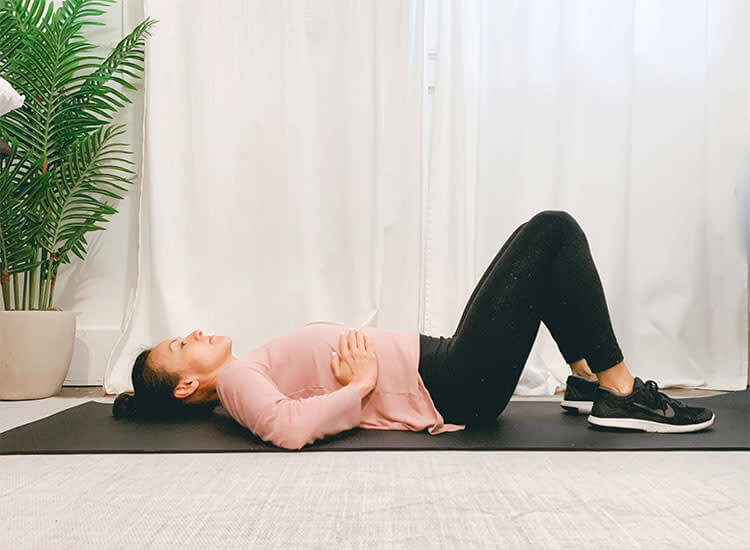
- Lie on your back on the floor. Place your feet about hip-width apart and 6-to-12 inches from your butt and your palms against the top of your belly, just below your ribs.
- While breathing naturally, contract your pelvic floor muscles and engage your abs by “pulling” them toward your spine.
- Hold the position for 5-to-10 seconds.
Pelvic Floor Tilt

- Lie on your back on the floor. Place your feet about hip-width apart and 6-to-12 inches from your butt and your arms by your sides with your palms facing the floor.
- Press your lower back into the floor, contract your pelvic floor muscles, and engage your abs by “pulling” them toward your spine.
- Inhale, then exhale slowly and lift your hips toward your head by “tucking” your tailbone toward the ceiling.
- Hold this position for 3-to-5 seconds and return to the starting position.
Heel Slide
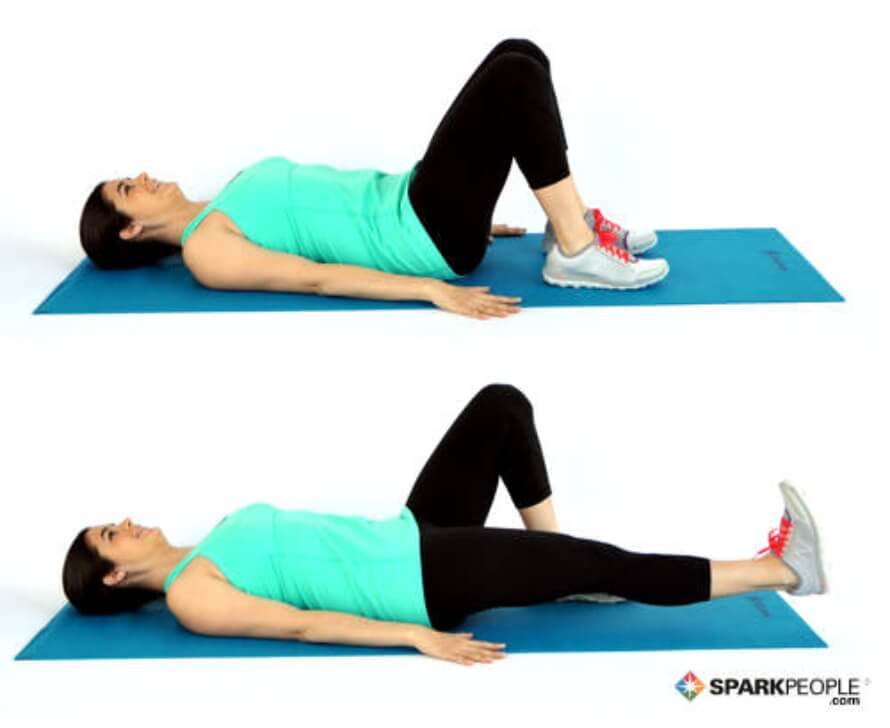
- Lie on your back on the floor. Place your feet about hip-width apart and 6-to-12 inches from your butt and your arms by your sides with your palms facing the floor.
- Contract your pelvic floor muscles and engage your abs by “pulling” them toward your spine.
- Inhale, then exhale slowly, sliding your left heel along the floor until your left leg is straight.
- Inhale and return your left leg to the starting position.
- Repeat the process with your right leg.
Heel Taps
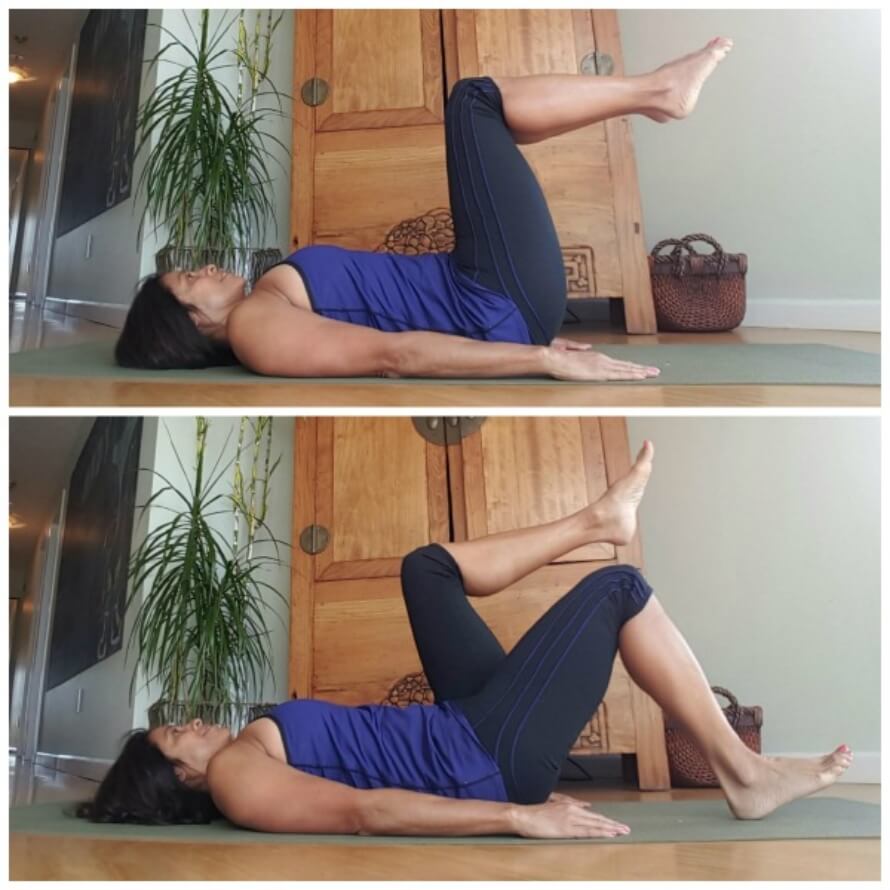
- Lie on your back on the floor. Place your feet about hip-width apart and 6-to-12 inches from your butt and your arms by your sides with your palms facing the floor.
- Lift your legs so that your thighs are perpendicular to the floor and your legs form a 90-degree angle.
- Contract your pelvic floor muscles and engage your abs by “pulling” them toward your spine.
- Without changing the angle of your knee, lower your left foot toward the floor until your left heel touches the floor.
- Return to the starting position then repeat with your right leg.
Dead Bug
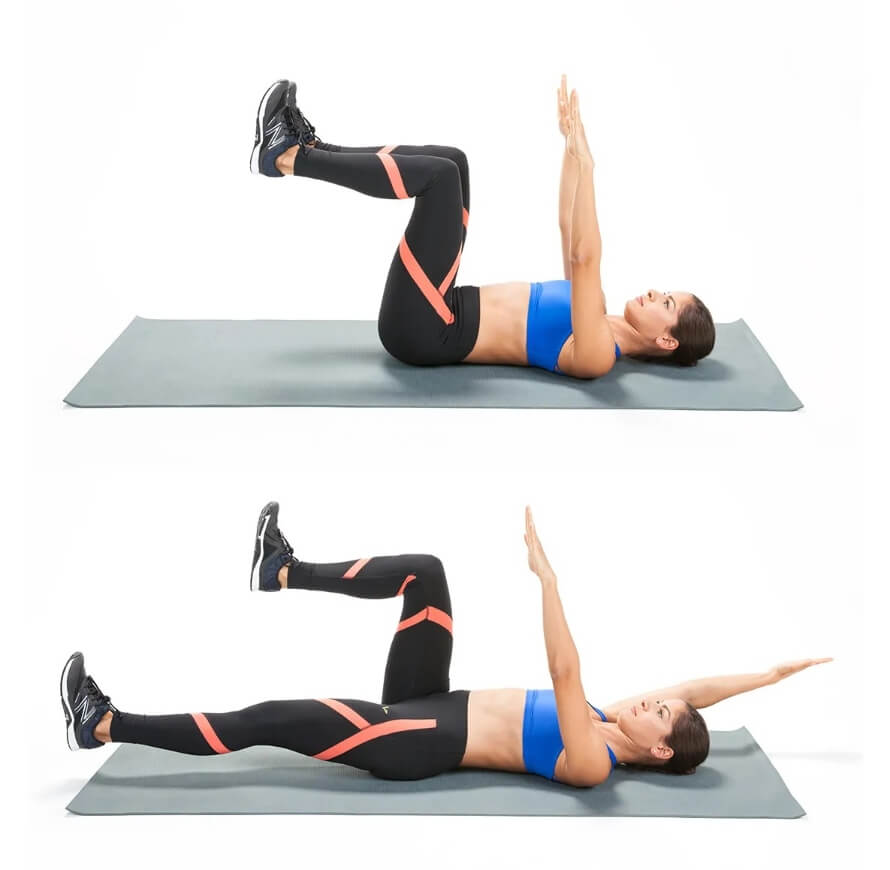
- Lie on your back on the floor. Place your feet about hip-width apart and 6-to-12 inches from your butt and your arms by your sides with your palms facing the floor.
- Lift your legs so that your thighs are perpendicular to the floor and your legs form a 90-degree angle. Then, without bending your elbows, lift your arms so they’re perpendicular to the floor.
- Contract your pelvic floor muscles and engage your abs by “pulling” them toward your spine.
- Extend your left leg until your left heel is 1-to-2 inches off the floor while simultaneously moving your right arm until it’s next to your right ear and your right hand is 1-to-2 inches off the floor.
- Reverse the movement and return to the starting position, then repeat with your right leg and left arm.
Reverse Plank
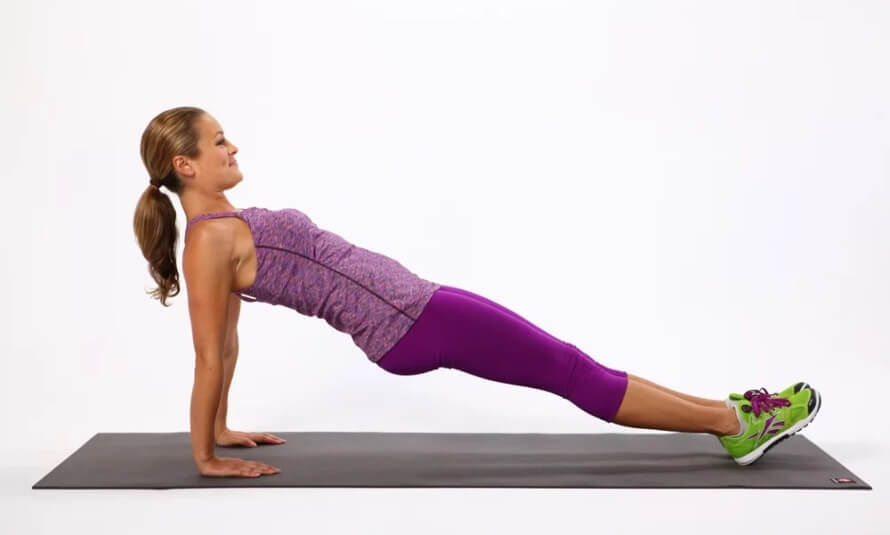
- Sit upright on the floor with your legs straight out in front of you. Plant your palms either side of your butt with your fingers pointing toward your feet.
- Pull your shoulder blades together and down, contract your pelvic floor muscles, and engage your abs by “pulling” them toward your spine.
- Inhale and press your hands into the floor while lifting your hips toward the ceiling so that your body forms a straight line from your shoulders to your feet.
- Hold the position for 20-to-30 seconds (or as long as you can), then lower your butt to the floor and return to the starting position.
Glute Bridge
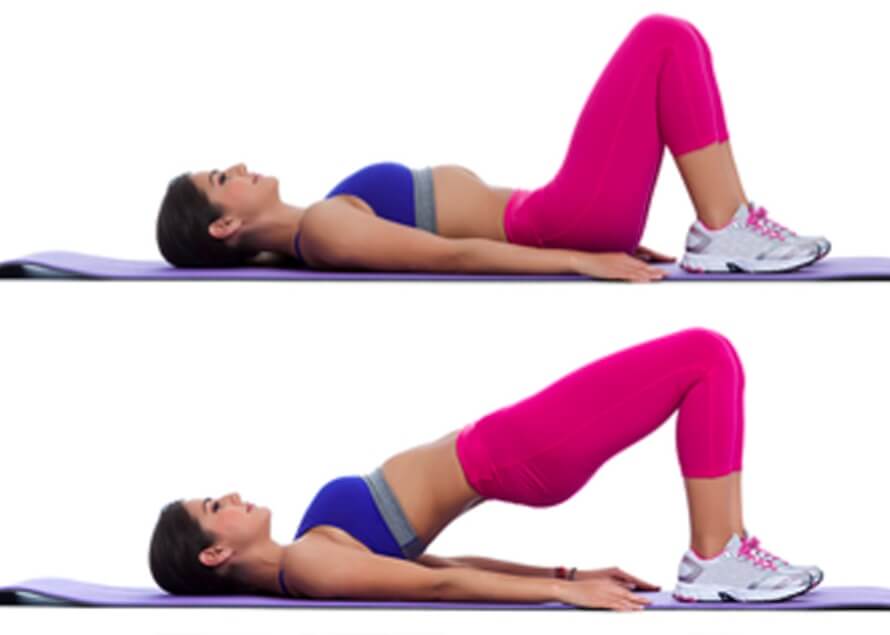
- Lie on your back on the floor. Place your feet about hip-width apart and 6-to-12 inches from your butt and your arms by your sides with your palms facing the floor.
- Contract your pelvic floor muscles and engage your abs by “pulling” them toward your spine.
- Lift your butt off the floor by pressing your shoulders and heels into the floor. Continue thrusting your hips upward until your butt, hips, and knees form a straight line and your shins are vertical.
- Hold the position for 5-to-10 seconds then reverse the movement and return to the starting position.
Bird Dog

- Get on all fours on the floor and contract your pelvic floor muscles and engage your abs by “pulling” them toward your spine.
- While keeping your spine and neck in a neutral position, extend your left leg backward until it’s parallel to the floor while simultaneously extending your right arm forward until it’s next to your right ear and your arm is parallel to the floor. At this point, there should be a straight line between your right hand and left foot.
- Hold the position for 5 seconds then reverse the movement and return to the starting position.
- Repeat the process with your right leg and left arm.
Alternating Single Leg Lift
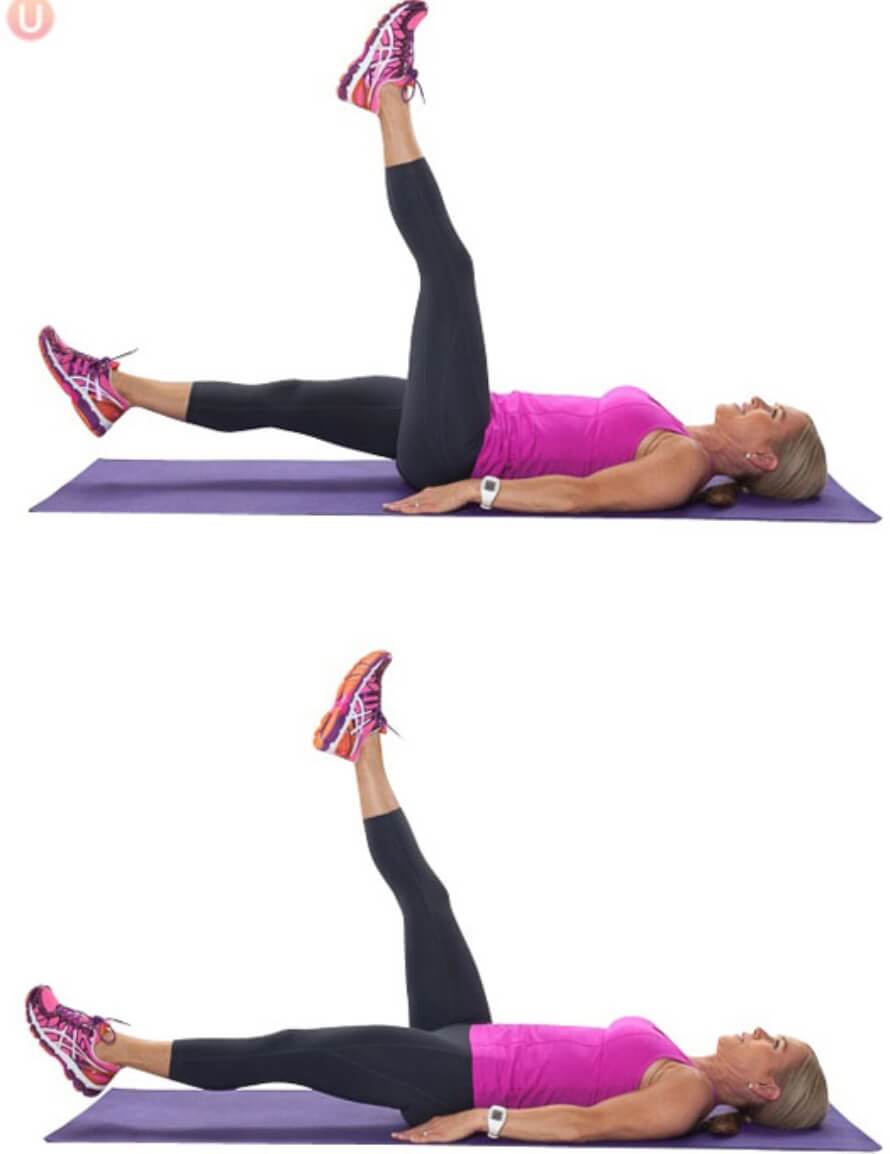
- Lie on your back on the floor with your legs extended and your arms by your sides with your palms facing the floor.
- Press your lower back into the floor, contract your pelvic floor muscles, and engage your abs by “pulling” them toward your spine.
- Without bending your knee, lift your left leg until it’s perpendicular to the floor (or as high as you can).
- Slowly lower your left leg to return to the starting position and repeat the process with your right leg.
Fire Hydrant
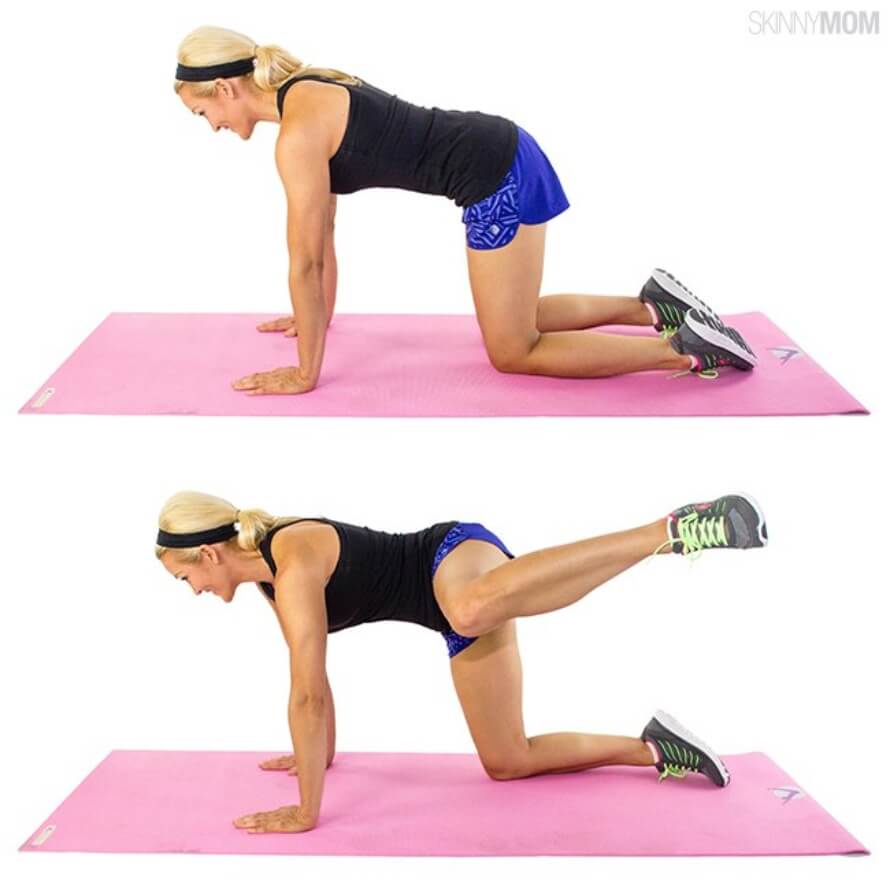
- Get on all fours on the floor and contract your pelvic floor muscles and engage your abs by “pulling” them toward your spine.
- Without changing the angle of your knee, lift your left leg out to the side as high as you comfortably can without twisting at the waist.
- Hold the position for 5 seconds then reverse the movement and return to the starting position.
- Repeat the process with your right leg.
Diastasis Recti Ab Workouts
Now that you know which exercises you should be doing, here’s how to organize them into workouts.
Diastasis Recti Ab Workout 1
- Core Brace: 10 sets of 1 rep with 10-to-20 seconds rest between sets
- Pelvic Floor Tilt: 3 sets of 5-to-10 reps with 90 seconds rest between sets
- Heel Slide: 3 sets of 5-to-10 reps (on each side) with 90 seconds rest between sets
- Heel Taps: 3 sets of 5-to-10 reps (on each side) with 90 seconds rest between sets
Diastasis Recti Ab Workout 2
- Core Brace: 10 sets of 1 rep with 10-to-20 seconds rest between sets
- Dead Bug: 3 sets of 5-to-10 reps (on each side) with 90 seconds rest between sets
- Reverse Plank: 10 sets of 1 rep with 10-to-20 seconds rest between sets
- Glute Bridge: 3 sets 10 reps with 90 seconds rest between sets
Diastasis Recti Ab Workout 3
- Core Brace: 10 sets of 1 rep with 10-to-20 seconds rest between sets
- Bird Dog: 3 sets of 5-to-10 reps (on each side) with 90 seconds rest between sets
- Alternating Single Leg Lift: 3 sets of 5-to-10 reps (on each side) with 90 seconds rest between sets
- Fire Hydrant: 3 sets of 5-to-10 reps (on each side) with 90 seconds rest between sets
Diastasis Recti Ab Workout 4
- Core Brace: 10 sets of 1 rep with 10-to-20 seconds rest between sets
- Dead Bug: 2 sets of 5-to-10 reps (on each side) with 90 seconds rest between sets
- Bird Dog: 2 sets of 5-to-10 reps (on each side) with 90 seconds rest between sets
- Reverse Plank: 10 sets of 1 rep with 10-to-20 seconds rest between sets
- Alternating Single Leg Lift: 2 sets of 5-to-10 reps (on each side) with 90 seconds rest between sets
- Glute Bridge: 2 sets 10 reps with 90 seconds rest between sets
- Fire Hydrant: 2 sets of 5-to-10 reps (on each side) with 90 seconds rest between sets
The Legion 6-Week Diastasis Recti Workout Routine
Here’s a 6-week workout routine designed to accelerate your healing from diastasis recti.
For best results, perform the Breathing and Pelvic Floor Workout outlined above every day before you do your main workout of the day.
You can begin this routine as quickly as you feel comfortable, though most women will benefit from waiting at least a week after giving birth. During the time between giving birth and starting the program, perform the Breathing and Pelvic Floor Workout as often as you feel able (once per day is optimal).
If you have any doubts about whether your body is ready to begin exercising, consult with your doctor before you start.
Try to complete the workouts in one go. If you have to pause your training for any reason (including tending to your newborn), just pick up your workout where you left off once you’re free to do so.

5. Eat enough calories and protein.
Most research shows that eating in a calorie deficit (consuming fewer calories than you burn each day) postpartum is safe, provided you aren’t underweight or malnourished and consume a healthy diet that’s rich in vitamins and minerals.
That said, it probably isn’t the best option if you want to optimize your recovery.
That’s because several muscles including your abdominals need to recover after giving birth. Research shows that eating in a calorie deficit impairs your body’s ability to repair muscle tissue, which could elongate your post-birth recovery, especially if you’re also performing exercises to correct diastasis recti.
Thus, a better option is to eat at “maintenance calories” (consume about as many calories as you burn each day) until you’re fully recovered.
You should also try to consume 0.8-to-1 gram of protein per pound of body weight per day. This provides your body with the “building blocks” it needs to build and repair muscle tissue and help you recover from giving birth and your diastasis recti workouts. If you want a clean, convenient, and delicious source of protein, try Whey+ or Casein+.
(Or if you aren’t sure if Whey+ or Casein+ is right for you or if another supplement might be a better fit for your budget, circumstances, and goals, then take the Legion Supplement Finder Quiz! In less than a minute, it’ll tell you exactly what supplements are right for you. Click here to check it out.)
FAQ #1: Can I do exercises to avoid diastasis recti?
Yes.
Most research shows that women who follow a strength training program before and during their pregnancy are less likely to experience severe diastasis recti or may avoid it altogether.
If you want a well-designed training program that includes all the best exercises for training your entire body, including your core, check out Mike’s fitness book for women, Thinner Leaner Stronger.
(Or if you aren’t sure if Thinner Leaner Stronger is right for you or if another strength training program might be a better fit for your circumstances and goals, then take Legion Strength Training Quiz, and in less than a minute, you’ll know the perfect strength training program for you. Click here to check it out.)
FAQ #2: What are the best exercises to repair diastasis recti?
Droves of articles online claim to include the “best postpartum exercises for diastasis recti.”
While these articles might include plenty of workable exercises, there’s no way to know whether the exercises they recommend are the “best” since there’s no consensus in the scientific community about the best way to train postpartum.
That said, most successful protocols in published studies emphasize exercises that train your transverse abdominis and avoid exercises that involve lifting heavy weights or plyometrics.
It’s also worth noting that exercises that involve “crunching” remain controversial. As such, I don’t recommend doing exercises that involve crunch-type movements while recovering from diastasis recti until we have more evidence that they’re safe.
FAQ #3: Are the “diastasis recti exercises: before and after photos” you find online real?
Research shows that doing the right core exercises postpartum can help to minimize diastasis recti.
Since many of the before and after photos online are of women who have followed a well-designed core training program after giving birth, it’s reasonable to assume that most are genuine.
That said, some of the most striking before and after shots are published by companies that sell products, supplements, and training plans that help you “fix” diastasis recti. These images are more likely to have been doctored to make the women’s progress seem more impressive than it is and encourage you to purchase their wares.
Scientific References +
- Thabet, A. A., & Alshehri, M. A. (2019). Efficacy of deep core stability exercise program in postpartum women with diastasis recti abdominis: a randomised controlled trial. Journal of Musculoskeletal & Neuronal Interactions, 19(1), 62. /pmc/articles/PMC6454249/
- Gluppe, S., Engh, M. E., & Bø, K. (2021). What is the evidence for abdominal and pelvic floor muscle training to treat diastasis recti abdominis postpartum? A systematic review with meta-analysis. Brazilian Journal of Physical Therapy, 25(6), 664–675. https://doi.org/10.1016/J.BJPT.2021.06.006
- Gunnarsson, U., Stark, B., Dahlstrand, U., & Strigård, K. (2015). Correlation between Abdominal Rectus Diastasis Width and Abdominal Muscle Strength. Digestive Surgery, 32(2), 112–116. https://doi.org/10.1159/000371859
- Parker, M. D., Chambers, P., Lodge, J. P. A., & Pratt, J. R. (2008). ISCHEMIC REPERFUSION INJURY AND ITS INFLUENCE ON THE EPIGENETIC MODIFICATION OF THE DONOR KIDNEY GENOME. Transplantation, 86(2S), 15. https://doi.org/10.1097/01.TP.0000332723.44379.2B
- Benjamin, D. R., Frawley, H. C., Shields, N., van de Water, A. T. M., & Taylor, N. F. (2019). Relationship between diastasis of the rectus abdominis muscle (DRAM) and musculoskeletal dysfunctions, pain and quality of life: a systematic review. Physiotherapy, 105(1), 24–34. https://doi.org/10.1016/J.PHYSIO.2018.07.002
- Thabet, A. A., & Alshehri, M. A. (2019). Efficacy of deep core stability exercise program in postpartum women with diastasis recti abdominis: a randomised controlled trial. Journal of Musculoskeletal & Neuronal Interactions, 19(1), 62. /pmc/articles/PMC6454249/
- Boissonnault, J. S., & Blaschak, M. J. (1988). Incidence of diastasis recti abdominis during the childbearing year. Physical Therapy, 68(7), 1082–1086. https://doi.org/10.1093/PTJ/68.7.1082
- Dufour, S., Bernard, S., Murray-Davis, B., & Graham, N. (2019). Establishing Expert-Based Recommendations for the Conservative Management of Pregnancy-Related Diastasis Rectus Abdominis: A Delphi Consensus Study. Journal of Women’s Health Physical Therapy, 43(2), 73–81. https://doi.org/10.1097/JWH.0000000000000130
- El-Mekawy, H. S., Eldeeb, A. M., Lythy, M. A. E.-, & El-Begawy, A. F. (2013). Effect of Abdominal Exercises versus Abdominal Supporting Belt on Post-Partum Abdominal Efficiency and Rectus Separation. International Journal of Medical and Health Sciences, 7(1), 75–79. https://doi.org/10.5281/ZENODO.1334606
- Sheppard, S. (1996). The Role of Transversus Abdominus in Post Partum Correction of Gross Divarication Recti. Manual Therapy, 1(4), 214–216. https://doi.org/10.1054/MATH.1996.0272
- Mesquita, L. A., Machado, A. V., & Andrade, A. V. (1999). Fisioterapia para redução da diástase dos músculos retos abdominais no pós-parto. Revista Brasileira de Ginecologia e Obstetrícia, 21(5), 267–272. https://doi.org/10.1590/S0100-72031999000500004
- Litos, K. (2014). Progressive Therapeutic Exercise Program for Successful Treatment of a Postpartum Woman With a Severe Diastasis Recti Abdominis. Journal of Women’s Health Physical Therapy, 38(2), 58–73. https://doi.org/10.1097/JWH.0000000000000013
- Walton, L. M., Costa, A., LaVanture, D., McIlrath, S., & Stebbins, B. (2016). The effects of a 6 week dynamic core stability plank exercise program compared to a traditional supine core stability strengthening program on diastasis recti abdominis closure, pain, oswestry disability index (ODI) and pelvic floor disability index scores (PFDI). Physical Therapy and Rehabilitation, 3(1), 3. https://doi.org/10.7243/2055-2386-3-3
- Benjamin, D. R., van de Water, A. T. M., & Peiris, C. L. (2014). Effects of exercise on diastasis of the rectus abdominis muscle in the antenatal and postnatal periods: a systematic review. Physiotherapy, 100(1), 1–8. https://doi.org/10.1016/J.PHYSIO.2013.08.005
- Carlstedt, A., Bringman, S., Egberth, M., Emanuelsson, P., Olsson, A., Petersson, U., Pålstedt, J., Sandblom, G., Sjödahl, R., Stark, B., Strigård, K., Tall, J., & Theodorsson, E. (2021). Management of diastasis of the rectus abdominis muscles: recommendations for swedish national guidelines. Scandinavian Journal of Surgery : SJS : Official Organ for the Finnish Surgical Society and the Scandinavian Surgical Society, 110(3), 452–459. https://doi.org/10.1177/1457496920961000
- Chiarello, Cynthia M. PT, P., Falzone, L. A. P., M McCaslin, Kristin E. PT MS3;, Patel Mita N. PT, MS4; Ulery, & Kristen R. PT, M. (n.d.). The Effects of an Exercise Program on Diastasis Recti Abdomi... : Journal of Women’s Health Physical Therapy. Retrieved September 20, 2022, from https://journals.lww.com/jwhpt/Fulltext/2005/29010/The_Effects_of_an_Exercise_Program_on_Diastasis.3.aspx
- Keeler, J., Albrecht, M., Eberhardt, L., Horn, L., Donnelly, C., & Lowe, D. (2012). Diastasis Recti Abdominis: A Survey of Women’s Health Specialists for Current Physical Therapy Clinical Practice for Postpartum Women. Undefined, 36(3), 131–142. https://doi.org/10.1097/JWH.0B013E318276F35F
- Thabet, A. A., & Alshehri, M. A. (2019). Efficacy of deep core stability exercise program in postpartum women with diastasis recti abdominis: a randomised controlled trial. Journal of Musculoskeletal & Neuronal Interactions, 19(1), 62. /pmc/articles/PMC6454249/
- Gitta, S., Magyar, Z., Tardi, P., Fuge, I., Jaromi, M., Acs, P., Garai, J., Bodis, J., & Hock, M. (2016). How to Treat Diastasis Recti Abdominis with Physical Therapy: A Case Report. Journal of Diseases, 3(2), 16–20. https://doi.org/10.18488/JOURNAL.99/2016.3.2/99.2.16.20
- Acharry, N., & Kutty, R. K. (2015). ABDOMINAL EXERCISE WITH BRACING, A THERAPEUTIC EFFICACY IN REDUCING DIASTASIS-RECTI AMONG POSTPARTAL FEMALES. International Journal of Physiotherapy and Research, 3(2), 999–1005. https://doi.org/10.16965/IJPR.2015.122
- Ramesh Khandale, S., Hande, D., Graduate Student, P., Professor, A., Abdul, A., & Author, C. (2016). Effects of Abdominal Exercises on Reduction of Diastasis Recti in Postnatal Women. International Journal of Health Sciences & Research (Www.Ijhsr.Org), 6(6), 182. www.ijhsr.org
- Gruszczynska, D., & Truszczynska-Baszak, A. (2018). Exercises for pregnant and postpartum women with diastasis recti abdominis - Literature review. Advances in Rehabilitation, 32(3), 27–35. https://doi.org/10.5114/AREH.2018.80967
- Laframboise, F. C., Schlaff, R. A., & Baruth, M. (2021). Postpartum Exercise Intervention Targeting Diastasis Recti Abdominis. International Journal of Exercise Science, 14(3), 400. /pmc/articles/PMC8136546/
- Gustavsson, C., & Eriksson-Crommert, M. (n.d.). Physiotherapists’ and midwives’ views of increased inter recti abdominis distance and its management in women after childbirth. https://doi.org/10.1186/s12905-020-00907-9
- Gluppe, S., Engh, M. E., & Bø, K. (2021). What is the evidence for abdominal and pelvic floor muscle training to treat diastasis recti abdominis postpartum? A systematic review with meta-analysis. Brazilian Journal of Physical Therapy, 25(6), 664–675. https://doi.org/10.1016/J.BJPT.2021.06.006
- Dusdieker, L. B., Hemingway, D. L., & Stumbo, P. J. (1994). Is milk production impaired by dieting during lactation? The American Journal of Clinical Nutrition, 59(4), 833–840. https://doi.org/10.1093/AJCN/59.4.833
- Mohammad, M. A., Sunehag, A. L., & Haymond, M. W. (2009). Effect of dietary macronutrient composition under moderate hypocaloric intake on maternal adaptation during lactation. The American Journal of Clinical Nutrition, 89(6), 1821. https://doi.org/10.3945/AJCN.2008.26877
- Kominiarek, M. A., & Rajan, P. (2016). Nutrition Recommendations in Pregnancy and Lactation. The Medical Clinics of North America, 100(6), 1199. https://doi.org/10.1016/J.MCNA.2016.06.004
- Fukano, M., Tsukahara, Y., Takei, S., Nose-Ogura, S., Fujii, T., & Torii, S. (2021). Recovery of Abdominal Muscle Thickness and Contractile Function in Women after Childbirth. International Journal of Environmental Research and Public Health, 18(4), 1–9. https://doi.org/10.3390/IJERPH18042130
- Helms, E. R., Aragon, A. A., & Fitschen, P. J. (2014). Evidence-based recommendations for natural bodybuilding contest preparation: nutrition and supplementation. Journal of the International Society of Sports Nutrition 2014 11:1, 11(1), 1–20. https://doi.org/10.1186/1550-2783-11-20
- Stokes, T., Hector, A. J., Morton, R. W., McGlory, C., & Phillips, S. M. (2018). Recent Perspectives Regarding the Role of Dietary Protein for the Promotion of Muscle Hypertrophy with Resistance Exercise Training. Nutrients, 10(2). https://doi.org/10.3390/NU10020180










